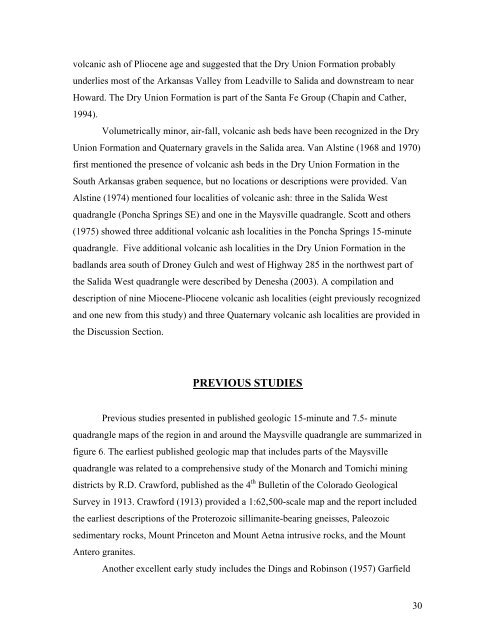Geologic Map of the Maysville Quadrangle, Chaffee County, Colorado
Geologic Map of the Maysville Quadrangle, Chaffee County, Colorado
Geologic Map of the Maysville Quadrangle, Chaffee County, Colorado
Create successful ePaper yourself
Turn your PDF publications into a flip-book with our unique Google optimized e-Paper software.
volcanic ash <strong>of</strong> Pliocene age and suggested that <strong>the</strong> Dry Union Formation probably<br />
underlies most <strong>of</strong> <strong>the</strong> Arkansas Valley from Leadville to Salida and downstream to near<br />
Howard. The Dry Union Formation is part <strong>of</strong> <strong>the</strong> Santa Fe Group (Chapin and Ca<strong>the</strong>r,<br />
1994).<br />
Volumetrically minor, air-fall, volcanic ash beds have been recognized in <strong>the</strong> Dry<br />
Union Formation and Quaternary gravels in <strong>the</strong> Salida area. Van Alstine (1968 and 1970)<br />
first mentioned <strong>the</strong> presence <strong>of</strong> volcanic ash beds in <strong>the</strong> Dry Union Formation in <strong>the</strong><br />
South Arkansas graben sequence, but no locations or descriptions were provided. Van<br />
Alstine (1974) mentioned four localities <strong>of</strong> volcanic ash: three in <strong>the</strong> Salida West<br />
quadrangle (Poncha Springs SE) and one in <strong>the</strong> <strong>Maysville</strong> quadrangle. Scott and o<strong>the</strong>rs<br />
(1975) showed three additional volcanic ash localities in <strong>the</strong> Poncha Springs 15-minute<br />
quadrangle. Five additional volcanic ash localities in <strong>the</strong> Dry Union Formation in <strong>the</strong><br />
badlands area south <strong>of</strong> Droney Gulch and west <strong>of</strong> Highway 285 in <strong>the</strong> northwest part <strong>of</strong><br />
<strong>the</strong> Salida West quadrangle were described by Denesha (2003). A compilation and<br />
description <strong>of</strong> nine Miocene-Pliocene volcanic ash localities (eight previously recognized<br />
and one new from this study) and three Quaternary volcanic ash localities are provided in<br />
<strong>the</strong> Discussion Section.<br />
PREVIOUS STUDIES<br />
Previous studies presented in published geologic 15-minute and 7.5- minute<br />
quadrangle maps <strong>of</strong> <strong>the</strong> region in and around <strong>the</strong> <strong>Maysville</strong> quadrangle are summarized in<br />
figure 6. The earliest published geologic map that includes parts <strong>of</strong> <strong>the</strong> <strong>Maysville</strong><br />
quadrangle was related to a comprehensive study <strong>of</strong> <strong>the</strong> Monarch and Tomichi mining<br />
districts by R.D. Crawford, published as <strong>the</strong> 4 th Bulletin <strong>of</strong> <strong>the</strong> <strong>Colorado</strong> <strong>Geologic</strong>al<br />
Survey in 1913. Crawford (1913) provided a 1:62,500-scale map and <strong>the</strong> report included<br />
<strong>the</strong> earliest descriptions <strong>of</strong> <strong>the</strong> Proterozoic sillimanite-bearing gneisses, Paleozoic<br />
sedimentary rocks, Mount Princeton and Mount Aetna intrusive rocks, and <strong>the</strong> Mount<br />
Antero granites.<br />
Ano<strong>the</strong>r excellent early study includes <strong>the</strong> Dings and Robinson (1957) Garfield<br />
30




